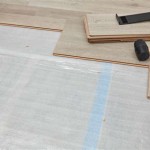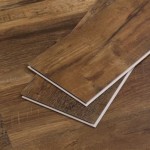Laying Vinyl Planks on Concrete Floors: A Comprehensive Guide
Vinyl planks have gained immense popularity as a durable and stylish flooring option for concrete surfaces. Installing vinyl planks on concrete requires careful preparation and attention to detail to ensure a seamless and long-lasting result.
1. Preparation:
Before laying vinyl planks, it's crucial to ensure the concrete surface is clean, level, and dry. Remove any existing flooring, nails, or debris, and level out any uneven areas using a self-leveling compound.
2. Moisture Control:
Concrete can be porous and prone to moisture, which can damage vinyl planks. Install a moisture barrier, such as a polyethylene film or moisture-resistant underlayment, to prevent moisture penetration.
3. Underlayment:
An underlayment layer provides cushioning and sound insulation. Choose a high-quality underlayment designed for use with vinyl planks, ensuring it is compatible with the specific plank type.
4. Acclimation:
Allow the vinyl planks to acclimate to the room temperature and humidity for at least 24 hours before installation. This helps prevent expansion or contraction after installation.
5. Laying the Planks:
Start laying the planks in a straight line from a corner of the room. Use a chalk line or laser level to ensure the first row is perfectly straight. Stagger the joints of the planks in a brick-like pattern.
6. Cutting Planks:
Precisely cut planks to fit around obstacles or create edge pieces. Use a sharp utility knife or a vinyl plank cutter to ensure clean and accurate cuts.
7. Interlocking the Planks:
Most vinyl planks feature an interlocking mechanism that simplifies installation. Align the edges of the planks and press them down firmly to lock them securely in place.
8. Expansion Gap:
Leave a small expansion gap around the perimeter of the room to allow for expansion and contraction due to temperature and humidity fluctuations.
9. Transitions and Moldings:
To create transitions between different flooring surfaces or around obstacles, use appropriate moldings or transition strips. These can be nailed, glued, or clicked into place.
10. Final Touches:
Once all the planks are installed, use a soft cloth to wipe away any excess adhesive or dirt. Trim off any excess underlayment and reinstall the baseboards or moldings.
Laying vinyl planks on concrete floors can be a rewarding home improvement project with proper preparation and careful execution. By following these essential steps, you can achieve a durable, stylish, and low-maintenance flooring solution that will enhance the beauty and functionality of your space.

How To Prepare A Concrete Floor For Vinyl Flooring Parrys

Easy Ways To Install Vinyl Plank Flooring On Concrete

Lvp Flooring Installation How To Install Luxury Vinyl Plank In A Basement Diy

Easy Ways To Install Vinyl Plank Flooring On Concrete

Tips For Installing Vinyl Plank Over Concrete Floors Lemon Thistle

Concrete Subfloor Preparation For The Vinyl Floor Installation How To Diy Mryoucandoityourself

Lvp Flooring Installation How To Install Luxury Vinyl Plank In A Basement Diy

Easy Ways To Install Vinyl Plank Flooring On Concrete

Tips And Tricks For Installing Vinyl Plank Over Concrete Floors Riverbend Interiors

Things To Know About Vinyl Flooring Floor Supplier
Related Posts








